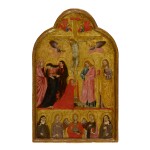
Sold Without Reserve | MASTER OF THE SAN TOMMASO DOSSAL | THE CRUCIFIXION WITH THE ARCHANGEL MICHAEL AND SAINTS ELIZABETH OF HUNGARY, AGNES, CATHERINE OF ALEXANDRIA AND CLARE; THE 'IMAGO PIETATIS' WITH THE DONOR FIGURES OF A FRANCISCAN FRIAR AND NUN ON THE VERSO
Auction Closed
May 22, 08:55 PM GMT
Estimate
300,000 - 500,000 USD
Lot Details
Description
Property from a Distinguished Private Collection, Sold Without Reserve
MASTER OF THE SAN TOMMASO DOSSAL
(active in Reggio Emilia, circa 1300-1325)
THE CRUCIFIXION WITH THE ARCHANGEL MICHAEL AND SAINTS ELIZABETH OF HUNGARY, AGNES, CATHERINE OF ALEXANDRIA AND CLARE; THE 'IMAGO PIETATIS' WITH THE DONOR FIGURES OF A FRANCISCAN FRIAR AND NUN ON THE VERSO
tempera on panel, gold ground, with an arched top
13½ by 8⅝ in.; 34.3 by 21.9 cm.
With Durlacher Brothers, London;
With Bacri Frères (no. 1027), Paris, by the 1930s;
From whom acquired by Sepp Angerer for the collection of Hermann Goering, Carinhall, July 1940;
At the Munich Central Collecting Point (card no. 6365);
Restituted to the owners, 25 March 1947, and by descent in the family;
By whom sold, New York, Sotheby's, January 28, 2010, lot 145 (as Emilian School, follower of Giotto, c. 1320);
There acquired.
N. Yeide, Beyond the Dreams of Avarice: The Hermann Goering Collection, Dallas 2009, no. A434, p. 289, reproduced p. 79;
D. Benati, "Da Reggio a Piacenza: pittori sulla via Emilia nella prima metà del Trecento," in S. Romano and D. Ceruti, L'artista girovago, Rome 2012, pp. 79-100, reproduced figs. 3, 4.
This panel, decorated on both sides and small enough to carry, most likely formed the central section of a portable triptych used for private devotion. The original patron must have been associated with the Poor Clares, as the saints on the lower register include St. Clare at far right and Elizabeth of Hungary at far left, a tertiary member of the order. On the reverse, the friar and nun adoring the Imago Pietatis or Man of Sorrows also wear Franciscan habits as they model behavior for the viewer. The master also included St. Andrew at the far right beneath the cross, an unusual iconographic element for the Crucifixion scene.
The painting has been previously attributed to a series of anonymous early-14th century masters from different regions of Italy, beginning with Federico Zeri’s attribution to an anonymous Riminese artist. Later, Filippo Todini considered the painting Umbrian, with connections to the work of Marino da Perugia, and Andrea De Marchi suggested the Primo Maestro di Chiaravalle who worked in fresco in Milan and Bergamo circa 1320-30. Keith Christiansen proposed an attribution to the Maestro Espressionista di Santa Chiara, one of Giotto’s collaborators in Assisi. Most scholars agree that the artist was of the first generation of Giotto’s followers or collaborators and working in the first quarter of the trecento.
More recently, Daniele Benati has given this panel, along with several other early-14th century works, to the Master of the San Tommaso Dossal. This master’s eponymous work is a dossal with the Incredulity of St. Thomas and a litany of saints now in the Galleria Antonio Fontanesi in the artist’s native Reggio Emilia. The figures of the saints on the latter dossal bear striking similarities to those on the present Crucifixion. The artist depicted the angels' wings here in a schematic, colorful way that situates the painting in Emilia circa 1320, and suggests a slightly archaic style. While the San Tommaso Master did not follow Giotto's turn toward naturalism in all elements of the composition, he did construct a more three-dimensional space than earlier Byzantine painting by overlapping the figures below the cross to indicate spatial recession. We are grateful to Dr. Daniele Benati for confirming the attribution to the Master of the San Tommaso Dossal and for assistance in the cataloging of this lot.
